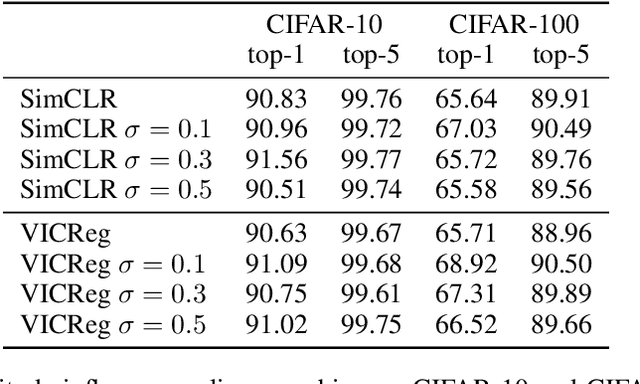Alexey Frolov
Efficient Distribution Matching of Representations via Noise-Injected Deep InfoMax
Oct 09, 2024



Abstract:Deep InfoMax (DIM) is a well-established method for self-supervised representation learning (SSRL) based on maximization of the mutual information between the input and the output of a deep neural network encoder. Despite the DIM and contrastive SSRL in general being well-explored, the task of learning representations conforming to a specific distribution (i.e., distribution matching, DM) is still under-addressed. Motivated by the importance of DM to several downstream tasks (including generative modeling, disentanglement, outliers detection and other), we enhance DIM to enable automatic matching of learned representations to a selected prior distribution. To achieve this, we propose injecting an independent noise into the normalized outputs of the encoder, while keeping the same InfoMax training objective. We show that such modification allows for learning uniformly and normally distributed representations, as well as representations of other absolutely continuous distributions. Our approach is tested on various downstream tasks. The results indicate a moderate trade-off between the performance on the downstream tasks and quality of DM.
Mutual Information Estimation via Normalizing Flows
Mar 05, 2024Abstract:We propose a novel approach to the problem of mutual information (MI) estimation via introducing normalizing flows-based estimator. The estimator maps original data to the target distribution with known closed-form expression for MI. We demonstrate that our approach yields MI estimates for the original data. Experiments with high-dimensional data are provided to show the advantages of the proposed estimator.
Information Bottleneck Analysis of Deep Neural Networks via Lossy Compression
May 13, 2023Abstract:The Information Bottleneck (IB) principle offers an information-theoretic framework for analyzing the training process of deep neural networks (DNNs). Its essence lies in tracking the dynamics of two mutual information (MI) values: one between the hidden layer and the class label, and the other between the hidden layer and the DNN input. According to the hypothesis put forth by Shwartz-Ziv and Tishby (2017), the training process consists of two distinct phases: fitting and compression. The latter phase is believed to account for the good generalization performance exhibited by DNNs. Due to the challenging nature of estimating MI between high-dimensional random vectors, this hypothesis has only been verified for toy NNs or specific types of NNs, such as quantized NNs and dropout NNs. In this paper, we introduce a comprehensive framework for conducting IB analysis of general NNs. Our approach leverages the stochastic NN method proposed by Goldfeld et al. (2019) and incorporates a compression step to overcome the obstacles associated with high dimensionality. In other words, we estimate the MI between the compressed representations of high-dimensional random vectors. The proposed method is supported by both theoretical and practical justifications. Notably, we demonstrate the accuracy of our estimator through synthetic experiments featuring predefined MI values. Finally, we perform IB analysis on a close-to-real-scale convolutional DNN, which reveals new features of the MI dynamics.
Soft-Output Deep Neural Network-Based Decoding
Apr 18, 2023Abstract:Deep neural network (DNN)-based channel decoding is widely considered in the literature. The existing solutions are investigated for the case of hard output, i.e. when the decoder returns the estimated information word. At the same time, soft-output decoding is of critical importance for iterative receivers and decoders. In this paper, we focus on the soft-output DNN-based decoding problem. We start with the syndrome-based approach proposed by Bennatan et al. (2018) and modify it to provide soft output in the AWGN channel. The new decoder can be considered as an approximation of the MAP decoder with smaller computation complexity. We discuss various regularization functions for joint DNN-MAP training and compare the resulting distributions for [64, 45] BCH code. Finally, to demonstrate the soft-output quality we consider the turbo-product code with [64, 45] BCH codes as row and column codes. We show that the resulting DNN-based scheme is very close to the MAP-based performance and significantly outperforms the solution based on the Chase decoder. We come to the conclusion that the new method is prospective for the challenging problem of DNN-based decoding of long codes consisting of short component codes.
 Add to Chrome
Add to Chrome Add to Firefox
Add to Firefox Add to Edge
Add to Edge